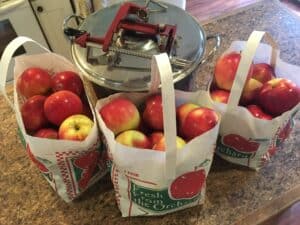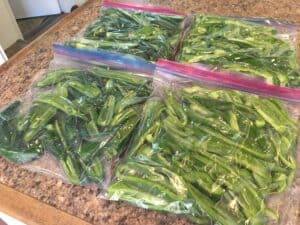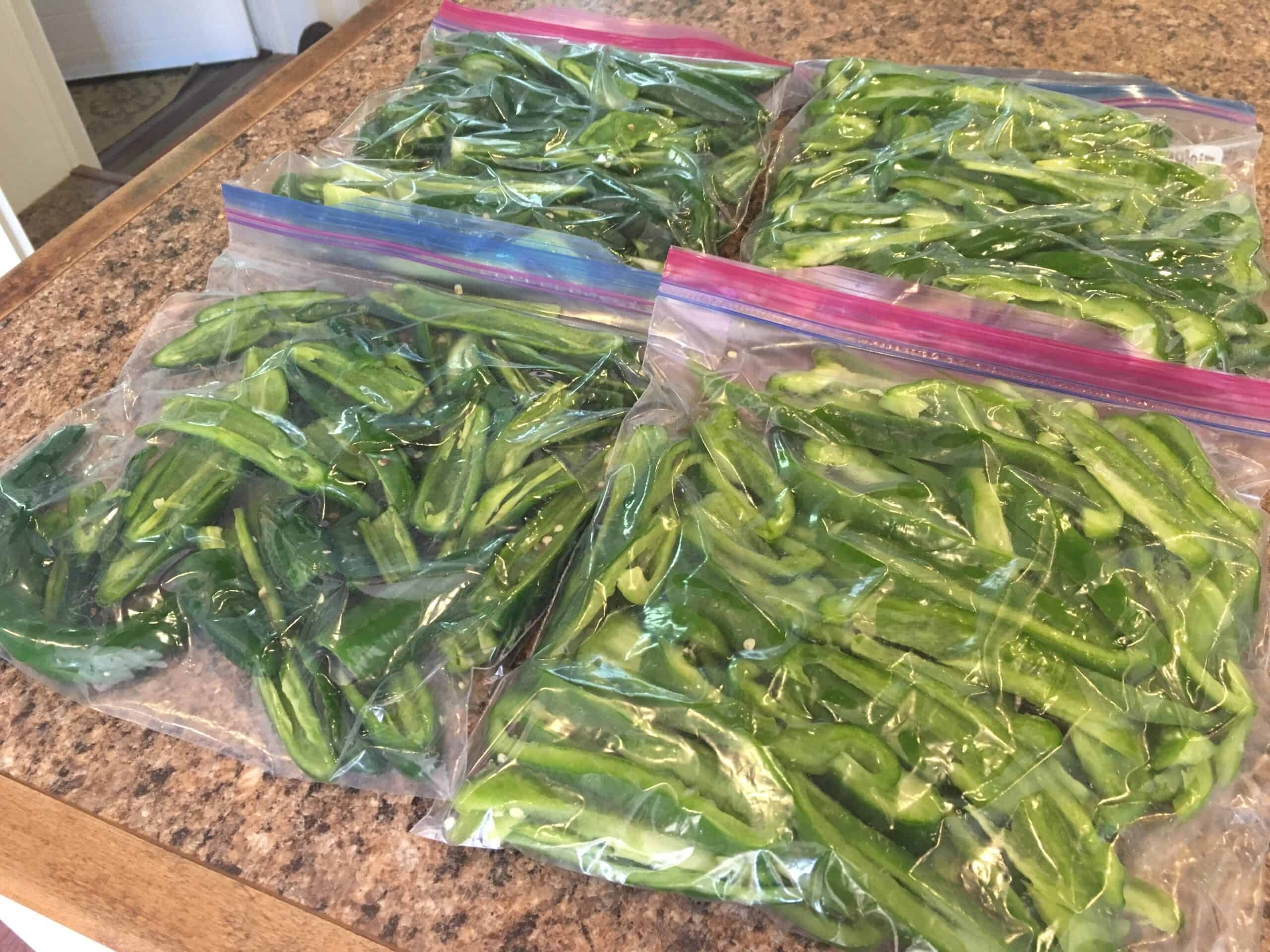So, today I’m going to talk a bit about freezer organization. I know, I know … real exciting stuff! Having a freezer or two in your home is a great way to save money, lessen the number of trips you need to take to the grocery store and to be able to preserve things for later use.
In our house, we have two medium-sized chest freezers, plus of course, the small freezer that is part of our refrigerator.
What We Store in Our Freezers
 We use one chest freezer for meat, seafood, onions, peppers, and anything else that potentially has a “smell” even when frozen. Trust me, you don’t want to store a bag of frozen onions next to a bag of frozen blueberries!
We use one chest freezer for meat, seafood, onions, peppers, and anything else that potentially has a “smell” even when frozen. Trust me, you don’t want to store a bag of frozen onions next to a bag of frozen blueberries!
We use the other chest freezer for frozen fruit, vegetables, leftovers and/or meal prep items, ice cream, and more.
The refrigerator-freezer is home for our ice, frozen juice concentrate, smoothie packs, breakfast burritos, etc.
Saving Money with Freezer Use
Having a chest or upright freezer in your home can help you save money by stocking up on things when they are on sale and/or shopping in bulk. For example, if you purchase one pound of hamburger it is usually more expensive per pound than if you buy a 5 or 10-pound package. It’s easy to come home and repackage it into smaller packages with freezer paper.
Likewise, you can stock up on certain things when they are on sale – think about your favorite steak or even things like bacon and butter that don’t go on sale as often.
You can also save money with your freezer by being able to freeze leftovers and produce before you are able to eat them. Not every single food is frozen, but many things do just fine! Leftover chili, taco meat, grilled chicken … the sky is the limit. Bonus: freezing things like this makes for a bonus easy cooking night later!
It wouldn’t be accurate to talk about a freezer saving you money without talking about the cost of electricity for running a freezer. Depending on the size and model of your freezer, it is estimated by MyMoneyBlog.com to cost between $25-52 per year for that electricity.
Fewer Grocery Store Trips
Being able to store things in your freezer also enables you to make fewer trips to the grocery store. This is especially helpful during our current times due to the pandemic. It’s also helpful if you live a distance from the store, have small children that make shopping difficult, or simply just don’t really love grocery shopping.
This is also helpful in the event there is a specialty store even further from your home that you don’t get to shop at as often. For example, I live over an hour from the nearest store where I can purchase lamb, and I live almost four hours from the nearest Trader Joe’s. When you get to these places, buying extra for your favorites and being able to freeze as appropriate can be a really convenient way to be able to stock up.
Preserving the Harvest
My husband is an avid hunter and fisherman, and our meat freezer mostly contains venison, wild turkey, pheasant, duck, and walleye. This spring, we raise and butcher four broiler chickens for the first time, so that meat is in our freezer right now as well.
 I try to stock up on various types of fruit when they are in season, locally in Minnesota when possible (like strawberries and apples.) We have a pretty big ever-bearing red raspberry patch in our yard, so we end up with lots of berries to get us through the winter too! I often make jam, but we also like to keep some in the freezer for making smoothies, frozen drinks, oatmeal, desserts, and quick bread.
I try to stock up on various types of fruit when they are in season, locally in Minnesota when possible (like strawberries and apples.) We have a pretty big ever-bearing red raspberry patch in our yard, so we end up with lots of berries to get us through the winter too! I often make jam, but we also like to keep some in the freezer for making smoothies, frozen drinks, oatmeal, desserts, and quick bread.
We also grow a large garden each summer, so we freeze quite a few vegetables. We can green beans, zucchini relish, pickles, red and green salsa, and spaghetti sauce every year. Almost everything else that we don’t eat fresh ends up getting frozen.
But, did you know you can freeze ripe tomatoes whole until you have enough to make a big batch of something? Often in the summer, we end up with up to 40 pounds of tomatoes in our freezer at a time while we wait for our plants to produce enough for a big batch of sauce.
Also, there are just lots of things from the garden we prefer to freeze, like:
- Chopped hot and green peppers that we use throughout the year.
- Blanched potatoes that I either slice or shred.
- Sweet corn off the cob, kale, Swiss chard, collard greens, okra, butternut squash cubes, pumpkin puree
- Sliced onions that are ready to go for quick use in cooking.
- Whole garlic bulbs that we take out as needed.
- Large batches of baked Eggplant Parmesan frozen as dinner-sized portions.
- Batches of Baba Ganoush freeze well too.
- Vats of Peruvian Green Sauce for the freezer.

Unfortunately, I do use plastic freezer bags for most of the above. We do wash and reuse them whenever possible, usually multiple times.
But, for both environmental and health reasons I’d like to get away from using them as much. I haven’t explored the use of reusable silicon bags too much yet, but it’s something that I’m working towards.
One thing we really don’t freeze is green beans. Some people say you can freeze them without blanching … we disagree. Others say you can blanch and freeze them … we don’t care for them that way either. Otherwise, most vegetables and fruits do just fine in the freezer as long as you process them correctly. Over time you’ll learn what you like best and what your favorite way to do each thing is, too.
Upright vs. Chest Freezers
If you don’t have a large freezer at home yet and are shopping, there’s always the upright vs. chest freezer question. We have chest freezers, but I know some people prefer upright freezers.
I don’t have a huge opinion on it, but I know the “bottom” of the chest freezer situation can be a bit frustrating. We try to put whatever we have the most of in the bottom and pull a bit of that thing to the top so we don’t always have to be digging down to the bottom of the freezer. We have some boxes in the bottom of our freezer that help organize it, and we use grocery bags above that, and there are baskets in the top part of the freezer.
I think even if you have an upright freezer, finding a way to organize it that works for your family is the key.
Regular Defrosting & Organization
I recommend having a “person in charge” of the freezer in your house. In our house, that happens to be me. I know how that sounds … but I think it’s helpful because that person knows where everything is, and can easily open the freezer and find it and move on. You don’t want to have someone just digging around in the freezer randomly, because the longer you have that door open, it will build frost up inside over time and you will have to defrost it more often. Not to mention, digging around trying to find something in the freezer is FRUSTRATING.
I recommend defrosting and cleaning your freezers out on a regular basis. I probably do ours 3-4 times a year. It keeps them running well, but it also prevents you from finding surprises later. Though freezing does provide a longer-term storage option, you don’t want things just lying around down there in the bottom forever. As a general rule, we try to eat everything within a year or so of putting it in the freezer (though some things like bread and ice cream don’t stay good as long.)
Keeping an inventory list of some sort is also a good idea. You could have a list for each freezer of what is inside and its approximate location if you wanted, which helps other family members. It also can help you make sure you don’t “forget” about what’s inside and get things used accordingly. At one point, I tried to keep a spreadsheet, which ended up just being a little too much. Lately, the only list I’ve really been keeping is a list of things that we should be eating soon, to get them out of the freezer.
Want More Information?
I talk a bit more about freezing food as a form of food preservation in my how-to get started with a food preservation blog post. I also did a livestream a couple of weeks ago as part of my “What’s in Your Fridge?” series. Check it out below.
If you have any questions, I’d love to answer them for you in the comments!

